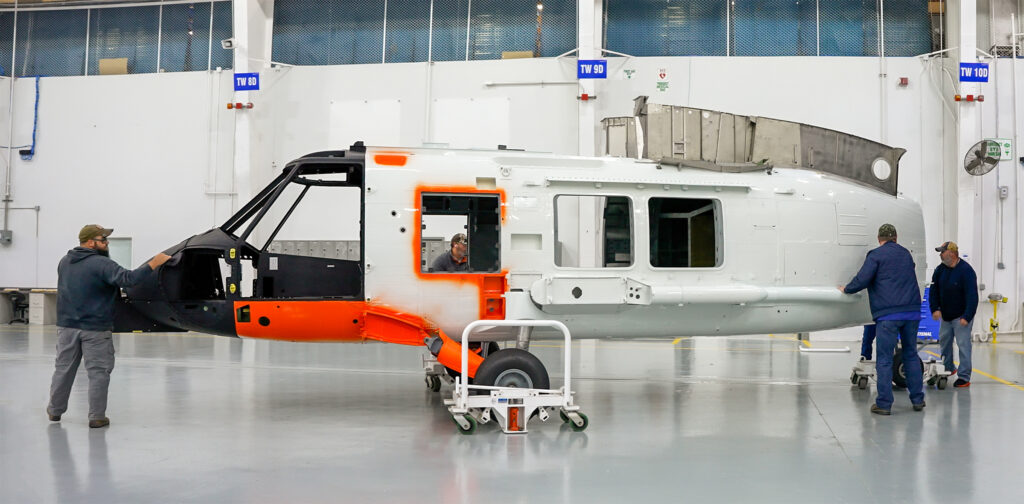
*****
By Richard R. Burgess, Senior Editor
ARLINGTON, Va.—The U.S. Coast Guard has confirmed plans to expand is MH-60T Jayhawk helicopter fleet and make it the standard service-wide helicopter. The service life-extension of the current MH-60T fleet is being highlighted as Sikorsky, a Lockheed Martin company, delivers the first of 45 replacement MH-60T airframes to the Coast Guard.
Sikorsky on Nov. 30, 2023, delivered the first new “hull,” as the airframe is called, which consists of the nose, cabin, and aft transition structure, combined as a single assembly, Sikorsky said in a release. Upon delivery, the new hull will be used to rebuild an older MH-60T with new and updated components by the Coast Guard’s Aviation Logistics Center (ALC) in Elizabeth City, North Carolina starting in December 2023.
The Coast Guard’s MH-60T fleet, the first of which originally began service as an HH-60J in 1990, is approaching the end of its service life of 20,000 hours per aircraft, with a current average of 16,000 flight hours per aircraft.
During the SLEP of 45 MH-60Ts, “the Coast Guard ALC will remove all dynamic (moving) components, digital cockpit, mission systems, and engines, then rebuild each aircraft around an all-new airframe,” Sikorsky said, noting that the company’s Troy, Alabama, facility is the site of the hull manufacture.
Sikorsky President Paul Lemmo told reporters at a Nov. 30 teleconference that the new hulls would be identical to those in the HH-60Js delivered between 1990 and 1996, but also would receive an anti-corrosion sealant in the joints.
The Coast Guard awarded Sikorsky a $374 million contract to deliver all 45 MH-60T airframes to the ALC at a rate of 12 per year through 2027. Full-rate production will begin with fabrication of the fourth hull. The MH-60Ts going through SLEP will retain their Coast Guard serial numbers.
Rear Adm. Michael Campbell, Coast Guard director of Acquisition Programs and program executive officer, also speaking at the teleconference, said that the Jayhawk fleet went through an earlier SLEP during which the airframe life was extended from 10,000 to 20,000 flight hours. He said that without the SLEP the MH-60T fleet would have to be grounded by 2028. With the current SLEP, the MH-60T fleet would serve into the late 2040s.
The first MH-60T with the new hull is expected to fly in June at the ALC.
The Jayhawks are put through overhaul every four years, with six in overhaul at any given time.
The Coast Guard currently operates 48 MH-60Ts, three of which will not receive the new hulls under this program because they were re-built with ex-U.S. Navy SH-60F or HH-60H helicopters. Some of the 45 Jayhawks receiving the new hulls also are ex-U.S. Navy H-60s that were re-built as Jayhawks.
According to the Coast Guard, the H-60 Jayhawk medium range recovery helicopter fleet has saved more than 11,900 lives during more than 48,300 search and rescue missions since 1990, accumulating more than 730,430 flight hours,” Sikorsky said in the release.
Campbell said the Coast Guard plans to increase the size of its Jayhawk fleet because of the capabilities of its national security cutters and forthcoming offshore patrol cutters and polar security cutters to hangar H-60 helicopters. The rotors and tail rotor boom of the MH-60T can be manually folded, but the rotors of the Navy H-60s have the capability to be electrically folded. The Coast Guard plans to install the electrical fold capability beginning in 2024.
The Coast Guard also plans to replace its fleet of 98 MH-65 Dolphin helicopters with MH-60Ts.
“The Coast Guard is moving forward with plans to transition the service’s rotary wing fleet to a standardized, single-platform fleet of MH-60Ts,” said Loretta Haring, Office of Strategic Planning and Communication (CG-925) Acquisition Directorate, in an email to reporters. “The Service plans to operate 127 airframes nationwide and intends to source the additional MH-60T hulls (termed “fleet growth”) through a combination of both newly manufactured hulls and Navy conversion hulls. The number of each to be used has not yet been determined. The initial phase of fleet growth likely will be 36 hulls.”






